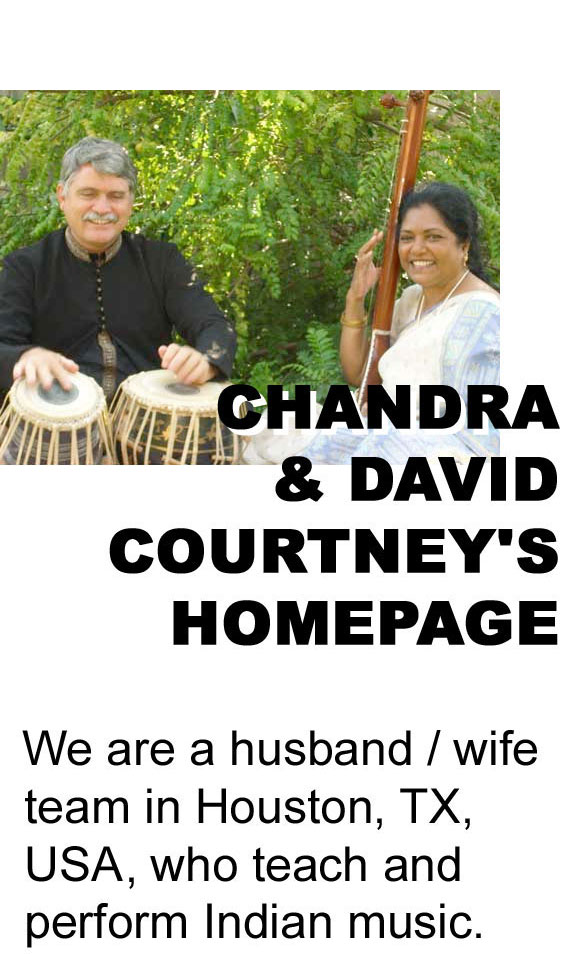MYTHOLOGICAL ORIGINS OF SANGEET

We must look at mythology to really see the significance that Indian music (sangeet) has to Indian society. This is easily illustrated in the story concerning its origin. Perhaps the clearest mythological raison de etre may be found in Bharata's Natya-Shastra(Rangacharya 1966):
| Once, a long time ago, during the transitional period between two Ages it so happened that people took to uncivilised ways, were ruled by lust and greed, behaved in angry and jealous ways with each other and not only gods but demons, evil spirits, yakshas and and such like others swarmed over the earth. Seeing this plight, Indra and other gods approached god Brahma and requested him to give the people a toy (Kridaniyaka), but one which could not only be seen but heard and this should turn out a diversion (so that people gave up their bad ways) |
Although it was decided to give the celestial art of sangeet to mankind, a suitable human had to be found who was capable of receiving this gift. Sangeet had always been in the realm of the demigods (gandharva. A super-human of superior spiritual ability was required to convey this celestial art-form to the world of man. It fell upon the great sage Narada to be the first mortal recipient of this divine art. Through Narada, we are indebted for the presence of classical music.
The introduction of this art-form to the mortal world was only the first step. Traditional pedagogy had to accommodate it. Classical music is considered more than mere entertainment; it is a moral and spiritual redeemer. Therefore, the divine qualities inherent in the art-form imply certain prerequisites; key among them are guru, vinaya and sadhana (Shankar 1968). This translates to teacher, humility, and discipline. The guru, or teacher is the most important prerequisite in traditional musical pedagogy. Music is said to be a guru mukha-vidhya (i.e., knowledge which must come from a teacher). This is considered the highest form of knowledge. Traditional pedagogy is based upon the transfer of knowledge from the teacher (guru) to the disciple (shishya in an unbroken tradition (parampara) (Courtney 1980). The tradition of guru-shishya-parampara extends back countless millennia. The second prerequisite is vinaya (humility). This also reflects the divine origins of the art-form. Classical music is said to be a worship that involves both the listener and the artist alike. Any negative emotions such as arrogance (abhiman) becomes an impediment. This is an impediment from both the divine aspect as well as a matter of simple pedagogy (e.g., "If you think you already know everything, then what is there to learn?") The final prerequisite for a student of classical music is sadhana (discipline and practice). Sadhana is necessary at two levels. At one level, the divine origins of the art-form require that the student "be prepared" to be a recipient of this knowledge. However, from a simple pedagogic standpoint, the music is so incredibly difficult that if the student does not devote countless hours of practice spread over many years, the student certainly will not be able to master the music.
This may clarify many points of pedagogy, but what about the art-form itself? Any art must deal with the topic of aesthetics. The Indian tradition has much to say on this point as well.
The ancient scriptures describe nine fundamental emotions from which all complex emotions may be produced. Just as all hues may be produced by mixing the three primary colours, so too, all emotions are said to be derived from these principal emotions (Shankar 1968). They are called navaras and are shown in the table below. These emotions form the aesthetic foundation for sangeet. We must remember that we are talking about music. This requires an acoustic vehicle to convey these emotions.
| The Nine Moods (Nava Rasa) |
| Shringar - Love Hasya - Comic Karuna - Sadness Raudra - Furious Veera - Heroic Bhayanak - Terrible Vibhats - Disgusting Adbhuta - Wonderment Shanta - Peace |
This acoustic vehicle is known as rag. Rag may be thought of as the melodic foundation upon which classical Indian music is based. During the last few centuries it was customary to anthropomorphise the rag in the form of gandharvas (demigods) and apsaras (celestial nymphs).
The divine quality of music is perhaps best illustrated in nad siddha. This is the ability to perform miracles by singing or playing certain rags. The most famous miracle-working musician was Tansen (Garg 1984). It is often said that he was able to create fire by singing rag Dipak, or create rain by singing rag Megh Malhar.
We have seen how this art-form is considered divine. This divine quality influences concepts such as aesthetics and pedagogy. The reverence that Indians have for this system may only be seen in a traditional approach.
However this does not bar us from taking a more objective approach.
© 1998 - 2020 David and Chandrakantha Courtney
For comments, corrections, and suggestions, kindly contact David Courtney at [email protected]
